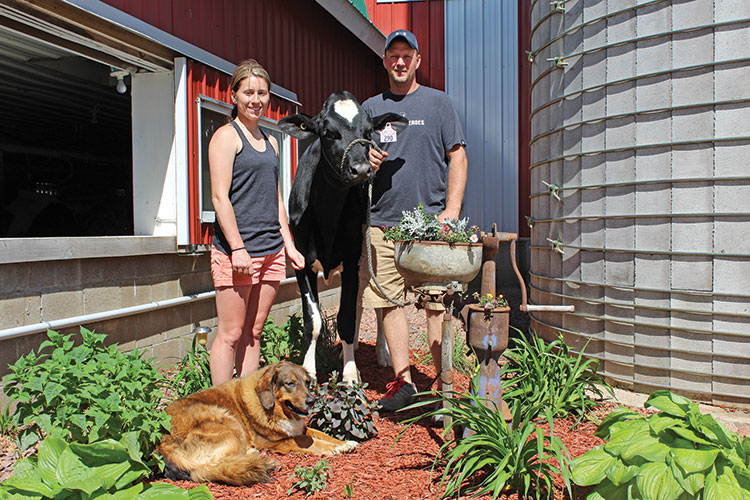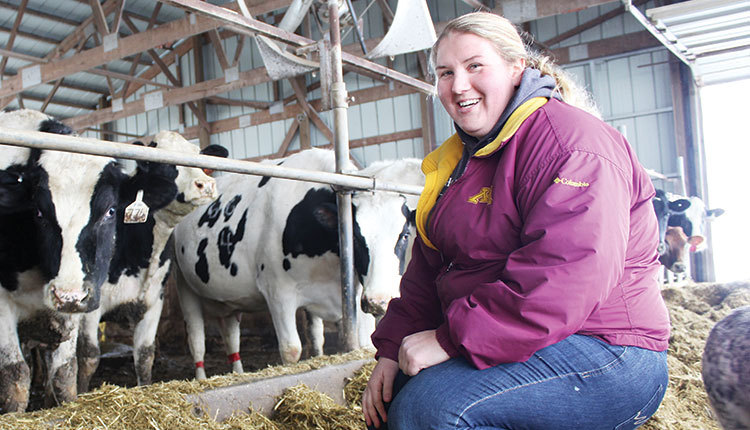The author grew up on a Jersey dairy farm in Gays Mills, Wis., and has been a multimedia journalist on radio and television.

With no family farm to call home, Adam Borchert of Tree-Hayven Holsteins started his future in the dairy industry by renting a farm in Auburndale, Wis., in 1998. He was just 18 at the time. By 2001, he bought that farm, the surrounding 160 acres of land, and the herd of 55 registered Holsteins.
Today, Borchert is a distinguished breeder whose genetics are wanted beyond Wisconsin’s borders. Tree-Hayven Holsteins has more than 30 animals classified as Excellent with their prefix. They stand 27th in the nation for breed age average (BAA) for their farm size with a classification score of 110.7. When asked the secret to his success, Borchert shrugged his shoulders and humbly said, “Trial and error.”
Behind the modest answer were more than 15 years of passion for continuous improvement. Borchert explained the Tree-Hayven prefix is built on proper calf and heifer care, foot health, genetics, and business networking.
Borchert purchased his first calf when he was 9-years-old. That calf, Whitetail-Valley Kirk Boy Ruby, eventually became his first foundation dam, proving the importance of each animal that enters the herd. Borchert and his girlfriend, Chelsey Karl, work closely with their young stock every day and have developed a system to minimize calf loss.
Clean, dry, and pasteurized
Tree-Hayven calves are born in fresh pens with video monitors to watch for calving difficulty. After the initial colostrum feeding, Adam and Chelsey give calves 2 quarts of pasteurized milk twice a day. Borchert invested in a pasteurizer five years ago and found his animals are uniformly stronger with it.
“We don’t have to waste time or money treating our calves as long as we keep them clean, dry, and fed,” Borchert said. “The pasteurizer helps calves develop the immunities they need.”
They enhance the milk’s protein value with pasteurizer balancers. After a few days, calves are offered water and calf starter. Within a week, they feed calves hay. Borchert claimed animals can develop greater rib capacity while fed hay-based diets. The calves are weaned after six weeks of milk consumption.
The words “clean” and “ventilated” are key for raising Tree-Hayven livestock. They keep calves and heifers in temperature-regulated buildings, which also provide better access for routine cleaning and administering vaccinations.
While quality heifer care can bring added investment, Borchert said healthy calves and heifers add to his farm’s profitability through private and public sales as well as better performance once in the milking string.
“It is not that Adam grows the biggest calves,” Kyli Brown, Borchert’s sister, said. “He grows healthy calves. People know when they get something from Tree-Hayven, it started off right and was cared for.”
Pasture and sand bedding
Tree-Hayven Holsteins raises those vibrant calves into cows that stand the test of time with an emphasis on leg and hoof care. Older heifers and dry cows have access to pasture to benefit feet and leg health. The cows are housed and milked in a stanchion barn, but they have opportunities for exercise while being fed outside if weather permits.
The farm switched from straw to sand bedding in the barn two years ago. Since then, Borchert said he saw a boost in milk production and improvements in overall foot health.
“When we just used straw, our cattle had puffy hocks, which can affect the entire cow’s health,” Borchert said. “The cows lay down more in the sand and it reduces the risks of knee and hock injuries.”
Sand bedding also lowered somatic cell counts and almost eliminated hairy warts, mastitis, and teat-end abrasions on the farm.
In addition to having all cows hoof trimmed twice a year, they use a footbath with copper sulfate and water. The solution hardens the hoof and toughens skin in vital areas between the claws, making them more resistant to bacterial infection, according to Borchert.
Borchert said his herd has greater longevity because of attention to feet and legs, so he can sell most animals as replacement dairy cows rather than cull beef cows at any age, prompting a more profitable sale.
“Breed for type and feed for production” is Tree-Hayven’s motto as the farm carefully considers what genetics to use for future generations of the herd.
Tree-Hayven also utilizes genomics to find bulls with calving ease when breeding heifers, but he relies heavily on pedigrees for finding good cow families with proven udder numbers as well as quality feet and legs.
“If you have a strong-bodied cow and the feed that fits your herd’s needs, you can reach your milk production goals,” Karl said. “Our nutrition plan also provides consistency in a cow’s milk production.”
To maintain steady milk production while breeding for type, cows are fed dry hay in the morning to stimulate the rumen and fed a TMR once a day. The farm tests feed for moisture and closely monitors the nutrient value of homegrown forages to help cows maintain production.
In the last five years, Borchert began using more embryo transfer and in vitro fertilization to grow his herd’s genetics. For example, one of their notable cows, Tree-Hayven Charles Peppermint Pati, classified as Excellent-93. She lived to be 12 years old, and her success as well as her offspring’s accomplishments prompted the family to keep her on a long-term flushing program.
Business networking
A profitable passion for Tree-Hayven Holsteins is showing cattle with Borchert’s 14-year-old daughter, Aaliyah, so their animals can prove their worth in the showring. The farm also hosts community events and farm tours to build relationships and show potential buyers how Tree-Hayven cattle are raised.
Borchert said selling show calves and heifers creates consistent cash flow while facing volatile milk prices. They classify every seven months to help market their prefix. In fact, 30 percent of Tree-Hayven’s income comes from selling genetics. The Wisconsin Holstein Association recognized these collective achievements by naming Adam Borchert and his entire Tree-Hayven team with its Distinguished Young Holstein Breeder Award.
“We never say no to a consignment or sale,” Borchert said. “That’s how we can help get our prefix out in the show cattle market.”
With social media, selling cattle can be easier than ever. Adam’s sister, Kyli, created and maintains Facebook, Instagram, and YouTube accounts for Tree-Hayven, where she posts regular farm updates. From one Facebook post alone, Tree-Hayven sold 10 head of cattle within 24 hours.
“Social media is free advertising,” Kyli said. “People want to see the cattle in their normal environment. We are in a society of instant gratification. The old days of putting advertisements in classifieds and newsprint takes too long and costs money.”
The future of Tree-Hayven Holsteins
From improving milk production to breeding cows with higher classification scores, Borchert is constantly creating new goals for Tree-Hayven Holsteins, saying, “We can always do better.”
His success thus far came from testing new on-farm practices and seeing what takes his herd to the next level, all while remembering his farm’s humble start nearly 15 years ago.










